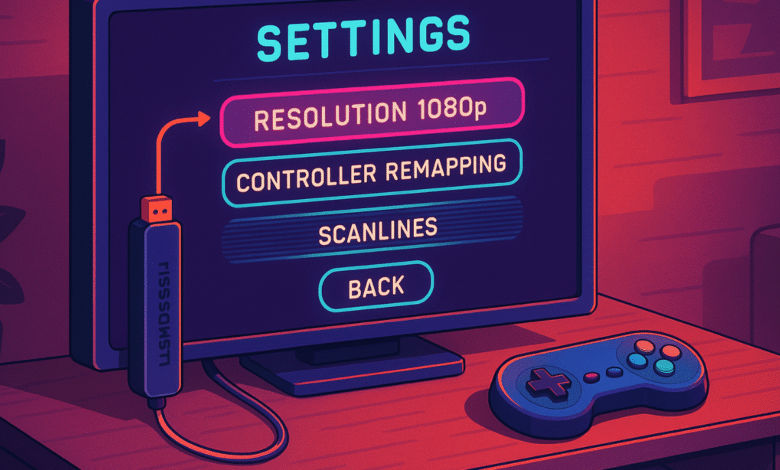Manual Settings HSSGameStick — Complete Guide for Setup and Troubleshooting

The HSSGameStick is one of the most talked-about plug-and-play retro gaming devices. Packed with classic games and designed to work right out of the box, it brings back the nostalgia of arcades and consoles on modern TVs. But while it is simple to use, many players quickly realize that performance, visuals, and controls can be optimized with the proper adjustments. This is where manual settings HSSGameStick become essential. By accessing the settings menu, you can fine-tune the resolution, adjust the audio, remap controllers, update the firmware, and resolve lag issues. This article serves as a comprehensive resource for understanding and utilizing manual settings, allowing you to optimize the potential of your gaming stick.
What Are Manual Settings HSSGameStick?
Manual settings refer to the customizable options within the HSSGameStick’s system interface. These allow players to move beyond the default factory setup and personalize the device’s performance. They include:
- Resolution and aspect ratio are examples of display parameters.
- Audio output adjustments for TVs and sound systems.
- Controller mapping and sensitivity tweaks.
- Firmware and system updates to keep the device smooth.
- Troubleshooting options to fix lag, screen issues, or unresponsive controllers.
Comprehending the process of accessing and configuring these options will give you more control over your gaming experience.
How to Access Manual Settings on the HSSGameStick
To begin configuring your device, follow these steps:
- Connect the HSSGameStick to your TV’s HDMI port.
- Plug the power supply into a USB adapter or directly into the TV if supported.
- Turn on your TV and switch to the correct HDMI channel.
- Once the system boots up, use the controller to navigate to the Settings Menu.
- From here, you’ll see sub-menus for display, sound, input (controllers), and system updates.
Display Settings in Manual Settings HSSGameStick
One of the most essential manual settings is video configuration. Without the proper setup, graphics may look stretched, blurry, or laggy.
Resolution Adjustments
- Options typically include 720p, 1080p, and 4K (depending on model).
- If you’re using a 4K TV, select either 1080p or 4K for the best crisp visuals.
- For older TVs, stick to 720p to prevent scaling issues.
Aspect Ratio
- Choose 4:3 for most retro titles to maintain the original look.
- Select 16:9 widescreen if you prefer full-screen playback (note that this may cause the image to be stretched).
Overscan and Screen Fit
- If parts of the image are cut off, adjust overscan settings.
- Some TVs also have a “Just Scan” or “Fit to Screen” option that pairs well with the HSSGameStick.
Audio Settings in Manual Settings HSSGameStick
Sound effects and background music play a significant role in retro gaming. The audio menu allows you to optimize playback.
- Output Mode: Choose between HDMI audio or Bluetooth (if supported).
- Volume Control: Adjust master volume or per-game settings.
- Sync Fixes: If you notice sound lag, reduce latency by changing buffer sizes in the system options.
Controller Settings in Manual Settings HSSGameStick
One of the most significant advantages of the HSS GameStick is its controller customization.
Pairing Controllers
- Insert the provided wireless dongle or use Bluetooth if available.
- Go to Controller Settings → Add Device.
- Press and hold the pairing button on the controller until it connects.
Button Remapping
- Select Input → Configure Controller.
- Press each button as prompted to match your desired layout.
- Save the profile so it loads automatically when you start up.
Sensitivity and Dead Zones
- Fine-tune analog stick sensitivity for smoother control.
- Adjust dead zones to reduce accidental movement in games.
Firmware and System Updates with Manual Settings HSSGameStick
Like most electronic devices, the HSSGameStick benefits from periodic updates. Updates often bring performance improvements, bug fixes, or new compatibility options.
Steps to update firmware:
- Ensure the device is connected to Wi-Fi.
- Go to Settings → System Update.
- Follow the prompts to download and install the latest firmware.
- Do not unplug the device during the installation process.
Updating regularly ensures your device remains secure and optimized.
Emulator and Game-Specific Options
Since the HSSGameStick often runs on an emulator-based frontend, you may also find per-game settings.
- Graphics Filters: Apply scanlines or smoothing filters for an authentic look.
- Core Selection: Select from various emulators for enhanced compatibility.
- Save States: Manually save progress in games that initially didn’t allow saving.
- Cheat Codes: Some emulators support cheats, which can be enabled through the manual settings.
Troubleshooting with Manual Settings HSSGameStick
Even with a plug-and-play device, problems can occur. Fortunately, the manual settings menu offers several tools to assist.
Common Issues and Fixes
No Video Output
- Check the HDMI connection.
- Try lowering the resolution from 4K to 1080p.
- Test with another HDMI port or cable.
Controller Not Responding
- Re-pair the controller using manual settings.
- Replace or recharge batteries.
- Try a wired connection if wireless fails.
Game Lag or Stuttering
- Lower resolution for smoother performance.
- Turn off unnecessary background features.
- Update firmware for performance patches.
Sound Not Working
- Ensure TV audio is set to HDMI input.
- Switch output mode from Bluetooth back to HDMI.
- Reset audio settings in the menu.
Optimization Tips for Best Performance
- Use Wired Connections: Wired controllers and stable HDMI cables reduce latency.
- Stick to Native Resolutions: Retro games look best in their original aspect ratio.
- Keep Firmware Updated: Prevents crashes and adds features.
- Back Up Your Settings: Some models allow you to export configuration files.
Frequently Asked Questions (FAQs)
Q1: How do I access manual settings on HSSGameStick?
Go to the Settings menu after booting up. You’ll see options for display, sound, controller, and system.
Q2: What resolution should I use on a 4K TV?
Use 1080p or 4K for the sharpest visuals. Lower resolutions may look stretched.
Q3: Can I use third-party controllers?
Yes, most versions support additional controllers via USB or Bluetooth.
Q4: How do I fix lag while playing games?
For optimal performance, use a lower resolution, update the firmware, and connect via wired controllers.
Q5: Is it safe to update firmware through manual settings?
Yes, as long as you don’t disconnect power during the update process.
Conclusion
The manual settings HSSGameStick unlocks the full potential of this retro gaming device. From optimizing resolution and sound to remapping controllers and applying firmware updates, these settings allow for a smoother, more personalized gaming experience.
You May Also Read: Ninjabytezone.com: Your One-Stop Hub for Gaming News, Tips, and Tech Trends




